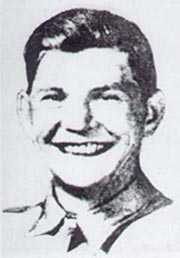Eddie Leonski
| Eddie Leonski | |
|---|---|
 | |
| Born |
December 12, 1917 New Jersey, United States |
| Died |
November 9, 1942 (aged 24) Victoria, Australia |
Cause of death | Execution |
| Other names |
The Brownout Strangler The Singing Strangler |
Criminal penalty | Death |
| Killings | |
| Victims | 3 |
Span of killings | May 3, 1942–May 18, 1942 |
| Country | Australia |
| State(s) | Victoria |
Edward Joseph Leonski (December 12, 1917 – November 9, 1942) was a United States Army soldier during World War II. He was also a serial killer responsible for the strangling murders of three women in Melbourne, Australia. Leonski was known as both the "Brownout Strangler", given Melbourne's wartime status of keeping low lighting (not as stringent as a wartime blackout) and also as the "Singing Strangler" due to his self-confessed motive for the killings being a twisted fascination with female voices, especially when they were singing, and his claim that he killed the women to "get at their voices."[1]
Early life
Born into a Polish-American family in New Jersey, Leonski grew up in an abusive, alcoholic family, and one of his brothers was committed to a mental institution. According to a psychologist who interviewed Leonski during his trial, his mother had been overprotective and controlling. Leonski had been bullied by other neighborhood kids and called a mama's boy. Accordingly, the psychologist ruled that Leonski's crimes were born of his resentment and hatred of his mother and thus constituted "symbolic matricide."
He was called up for the U.S. Army in February 1941 and arrived in Melbourne on February 2, 1942.
Murders
On May 3, 1942, Ivy Violet McLeod, 40, was found dead in Albert Park, Melbourne. She had been beaten and strangled, and because she was found to be in possession of her purse it was evident that robbery was not the motive.
Just six days later, 31-year-old Pauline Thompson was strangled after a night out. She was last seen in the company of a young man who was described as having an American accent.
Gladys Hosking, 40, was the next victim, murdered on May 18 while walking home from work at the Chemistry Library at Melbourne University. A witness said that, on the night of the killing, a disheveled American man had approached her asking for directions, seemingly out of breath and covered with mud. This description matched the individual Pauline Thompson was seen with on the night of her murder, as well as the descriptions given by several women who had survived recent attacks.
A very lucky Joan Robb, whom he had previously told had the voice of an angel, was due to have a date with him the night he was captured.
These survivors and other witnesses were able to pick 24-year-old Edward Leonski out of a line-up of American servicemen who were stationed in the city during World War II. A private in the 52nd Signal Battalion, Leonski was arrested and charged with three murders.
Trial and execution
Although Leonski's crimes were committed on Australian soil, the trial was heard under American military law. Private Leonski confessed to the crimes and was convicted and sentenced to death at a United States Army general court-martial on July 17, 1942. General Douglas MacArthur confirmed the sentence on October 14, 1942 and a Board of Review upheld the findings and sentence on October 28, 1942. General Court-Martial Order 1 promulgated Leonski's death sentence on November 1, 1942. In a departure from normal procedure, on November 4, 1942, MacArthur personally signed the order of execution (in subsequent executions, this administrative task was entrusted to MacArthur's Chief of Staff, Richard Sutherland). Leonski was hanged at Pentridge Prison on November 9, 1942, only the second American serviceman to be executed during World War II.
Leonski's defense attorney, Ira C. Rothgerber,[2] attempted to win an external review, even from the U.S. Supreme Court, but was unable to do so. Rothgerber kept the issue alive after the war, and Leonski's case contributed to the development of the Uniform Code of Military Justice (UCMJ).
Leonski was temporarily interred at several cemeteries in Australia. His remains were eventually permanently interred in Section 9, Row B, Site 8 at Schofield Barracks Post Cemetery (located between Wahiawa and Kunia) on the island of O'ahu. His grave is located in a portion of the facility reserved for general prisoners who died in military custody.
Fictional portrayals
The 1986 film Death of a Soldier is based on Leonski.
Notes
External links
| ||||||||||||||||||||||||||
|